Brit-tech Business Communication: Strategies, Barriers & Analysis
VerifiedAdded on 2023/06/12
|8
|1852
|300
Report
AI Summary
This report provides an analysis and discussion of business communication, focusing on theories of communication in organizations and barriers to effective communication. It explores Max Weber's Bureaucratic Theory and Tompkins' Control Theory, highlighting their relevance to organizational communication. The report identifies physical, mental/emotional, language, and technological barriers to effective communication and outlines Brit-tech strategies to overcome these barriers, such as providing training, adapting digital communication channels, and utilizing translation tools. Recommendations are made for organizations to adopt effective communication theories and strategies, emphasizing the importance of clear roles, training, and the use of digital communication channels. The report concludes that effective business communication is vital for reaching organizational objectives, developing business activities, and minimizing defects.
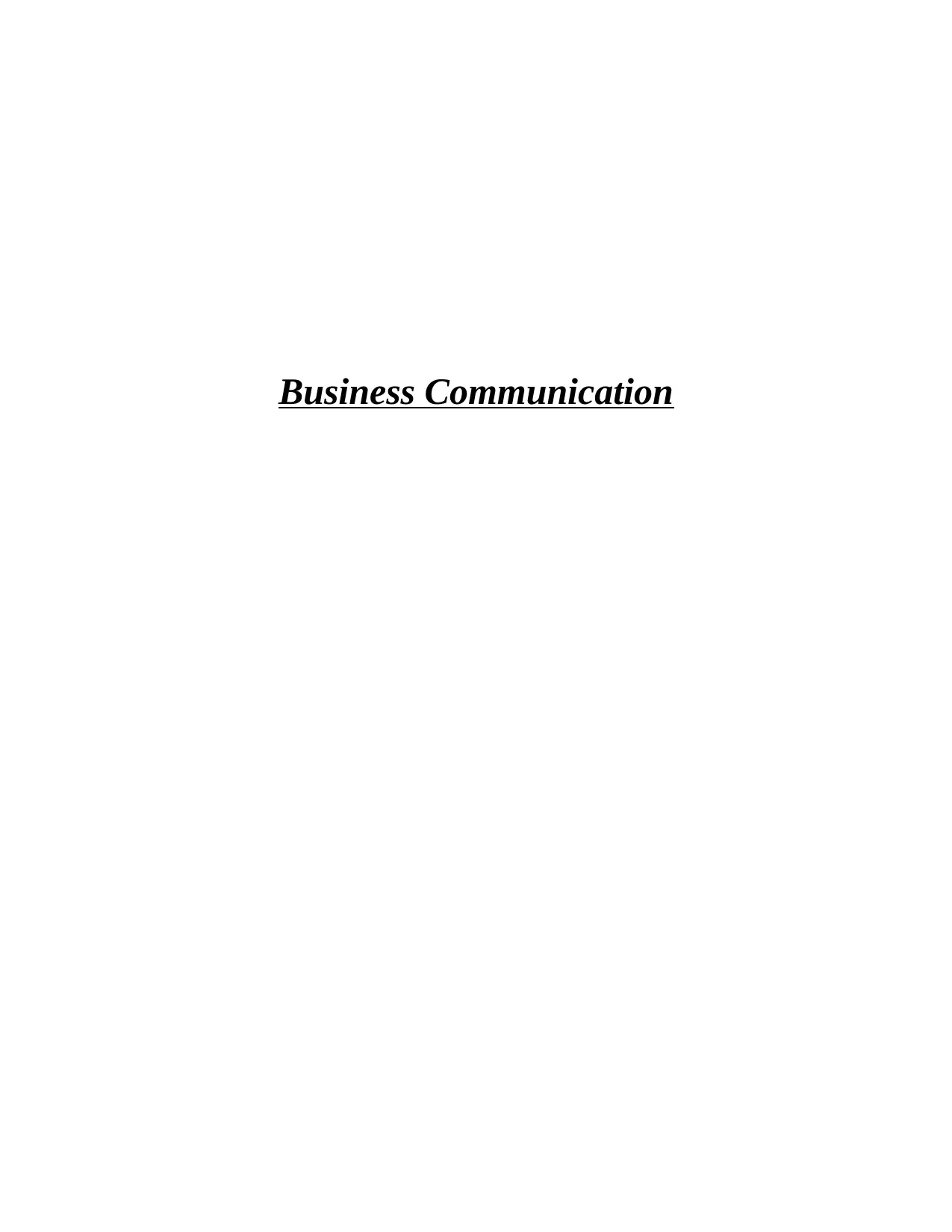
Business Communication
Paraphrase This Document
Need a fresh take? Get an instant paraphrase of this document with our AI Paraphraser
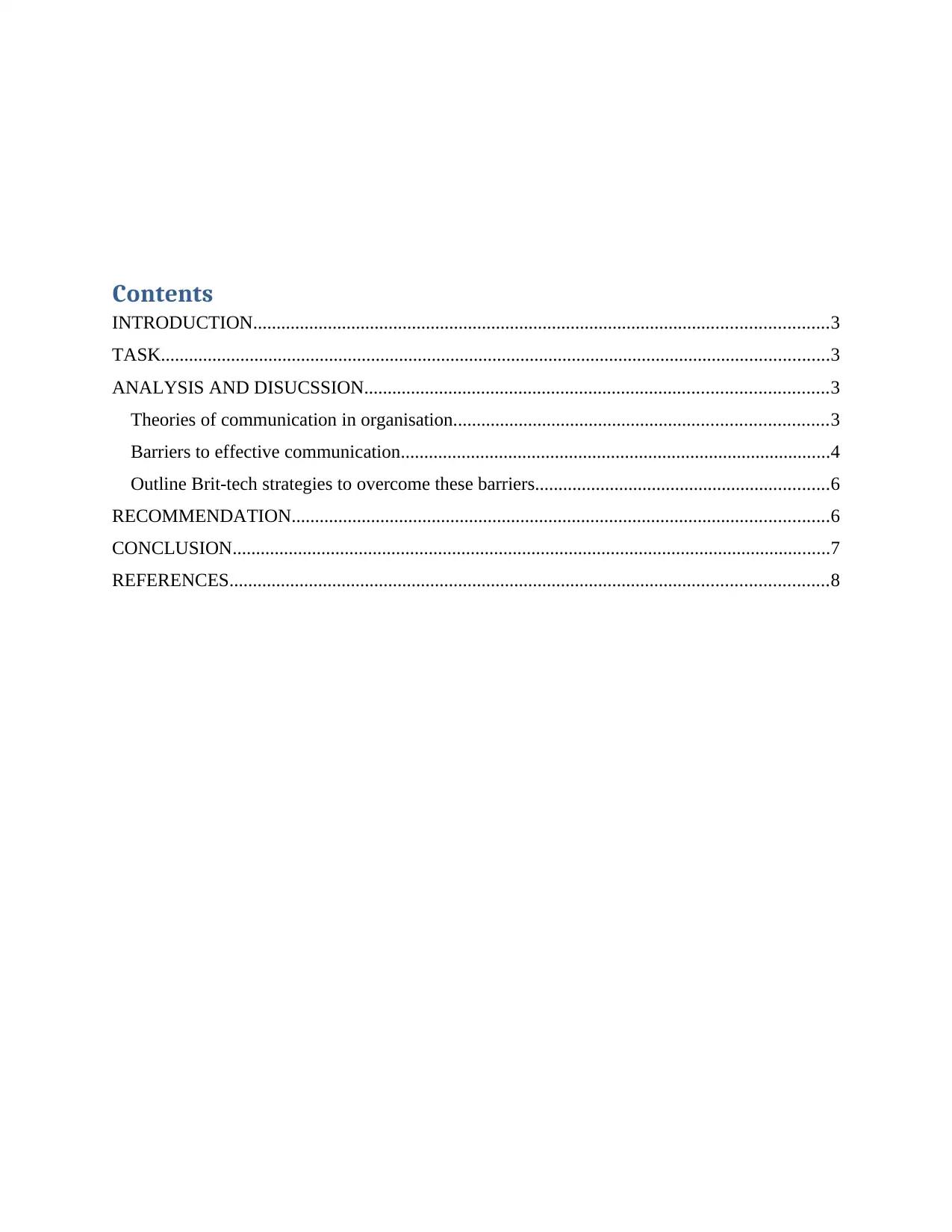
Contents
INTRODUCTION...........................................................................................................................3
TASK...............................................................................................................................................3
ANALYSIS AND DISUCSSION...................................................................................................3
Theories of communication in organisation................................................................................3
Barriers to effective communication............................................................................................4
Outline Brit-tech strategies to overcome these barriers...............................................................6
RECOMMENDATION...................................................................................................................6
CONCLUSION................................................................................................................................7
REFERENCES................................................................................................................................8
INTRODUCTION...........................................................................................................................3
TASK...............................................................................................................................................3
ANALYSIS AND DISUCSSION...................................................................................................3
Theories of communication in organisation................................................................................3
Barriers to effective communication............................................................................................4
Outline Brit-tech strategies to overcome these barriers...............................................................6
RECOMMENDATION...................................................................................................................6
CONCLUSION................................................................................................................................7
REFERENCES................................................................................................................................8
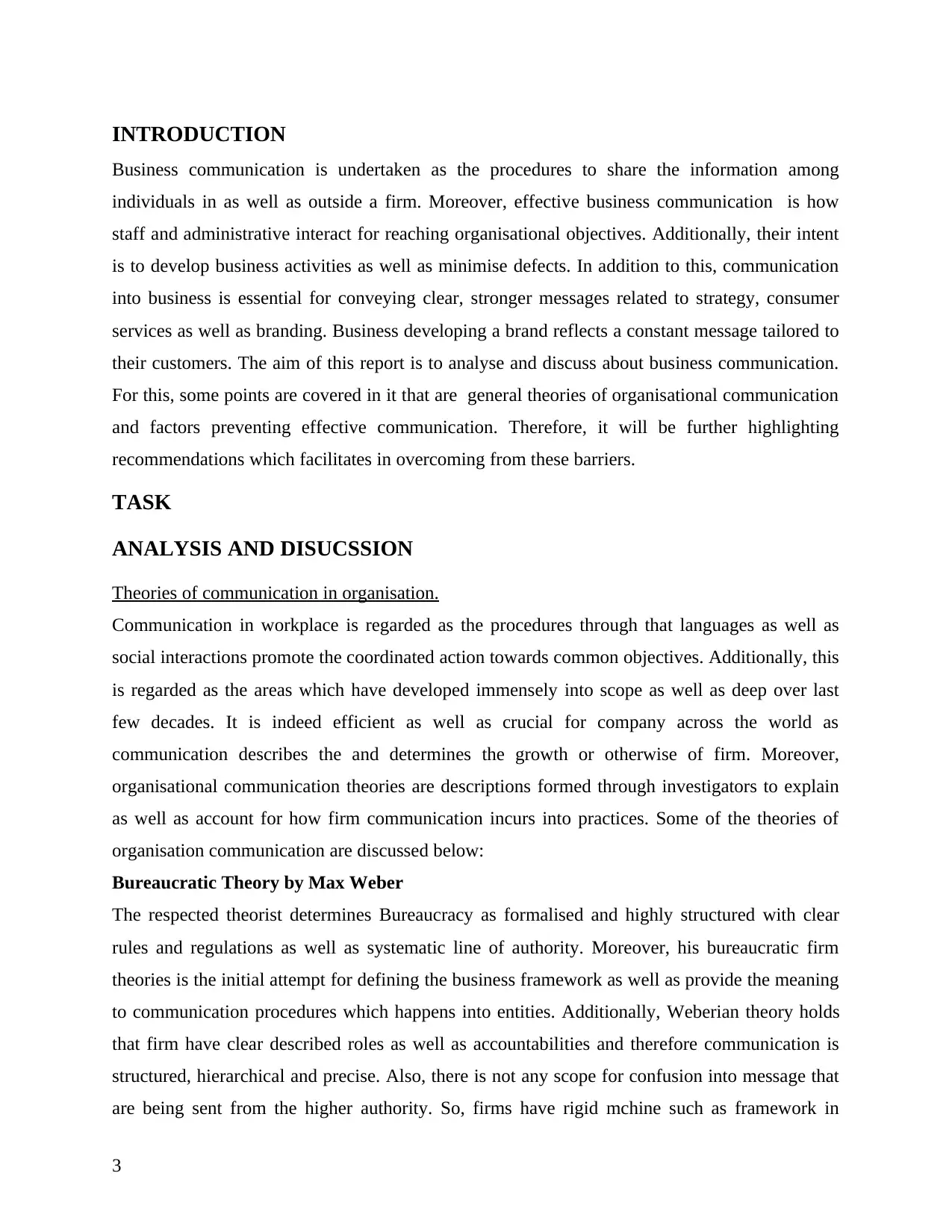
INTRODUCTION
Business communication is undertaken as the procedures to share the information among
individuals in as well as outside a firm. Moreover, effective business communication is how
staff and administrative interact for reaching organisational objectives. Additionally, their intent
is to develop business activities as well as minimise defects. In addition to this, communication
into business is essential for conveying clear, stronger messages related to strategy, consumer
services as well as branding. Business developing a brand reflects a constant message tailored to
their customers. The aim of this report is to analyse and discuss about business communication.
For this, some points are covered in it that are general theories of organisational communication
and factors preventing effective communication. Therefore, it will be further highlighting
recommendations which facilitates in overcoming from these barriers.
TASK
ANALYSIS AND DISUCSSION
Theories of communication in organisation.
Communication in workplace is regarded as the procedures through that languages as well as
social interactions promote the coordinated action towards common objectives. Additionally, this
is regarded as the areas which have developed immensely into scope as well as deep over last
few decades. It is indeed efficient as well as crucial for company across the world as
communication describes the and determines the growth or otherwise of firm. Moreover,
organisational communication theories are descriptions formed through investigators to explain
as well as account for how firm communication incurs into practices. Some of the theories of
organisation communication are discussed below:
Bureaucratic Theory by Max Weber
The respected theorist determines Bureaucracy as formalised and highly structured with clear
rules and regulations as well as systematic line of authority. Moreover, his bureaucratic firm
theories is the initial attempt for defining the business framework as well as provide the meaning
to communication procedures which happens into entities. Additionally, Weberian theory holds
that firm have clear described roles as well as accountabilities and therefore communication is
structured, hierarchical and precise. Also, there is not any scope for confusion into message that
are being sent from the higher authority. So, firms have rigid mchine such as framework in
3
Business communication is undertaken as the procedures to share the information among
individuals in as well as outside a firm. Moreover, effective business communication is how
staff and administrative interact for reaching organisational objectives. Additionally, their intent
is to develop business activities as well as minimise defects. In addition to this, communication
into business is essential for conveying clear, stronger messages related to strategy, consumer
services as well as branding. Business developing a brand reflects a constant message tailored to
their customers. The aim of this report is to analyse and discuss about business communication.
For this, some points are covered in it that are general theories of organisational communication
and factors preventing effective communication. Therefore, it will be further highlighting
recommendations which facilitates in overcoming from these barriers.
TASK
ANALYSIS AND DISUCSSION
Theories of communication in organisation.
Communication in workplace is regarded as the procedures through that languages as well as
social interactions promote the coordinated action towards common objectives. Additionally, this
is regarded as the areas which have developed immensely into scope as well as deep over last
few decades. It is indeed efficient as well as crucial for company across the world as
communication describes the and determines the growth or otherwise of firm. Moreover,
organisational communication theories are descriptions formed through investigators to explain
as well as account for how firm communication incurs into practices. Some of the theories of
organisation communication are discussed below:
Bureaucratic Theory by Max Weber
The respected theorist determines Bureaucracy as formalised and highly structured with clear
rules and regulations as well as systematic line of authority. Moreover, his bureaucratic firm
theories is the initial attempt for defining the business framework as well as provide the meaning
to communication procedures which happens into entities. Additionally, Weberian theory holds
that firm have clear described roles as well as accountabilities and therefore communication is
structured, hierarchical and precise. Also, there is not any scope for confusion into message that
are being sent from the higher authority. So, firms have rigid mchine such as framework in
3
⊘ This is a preview!⊘
Do you want full access?
Subscribe today to unlock all pages.

Trusted by 1+ million students worldwide
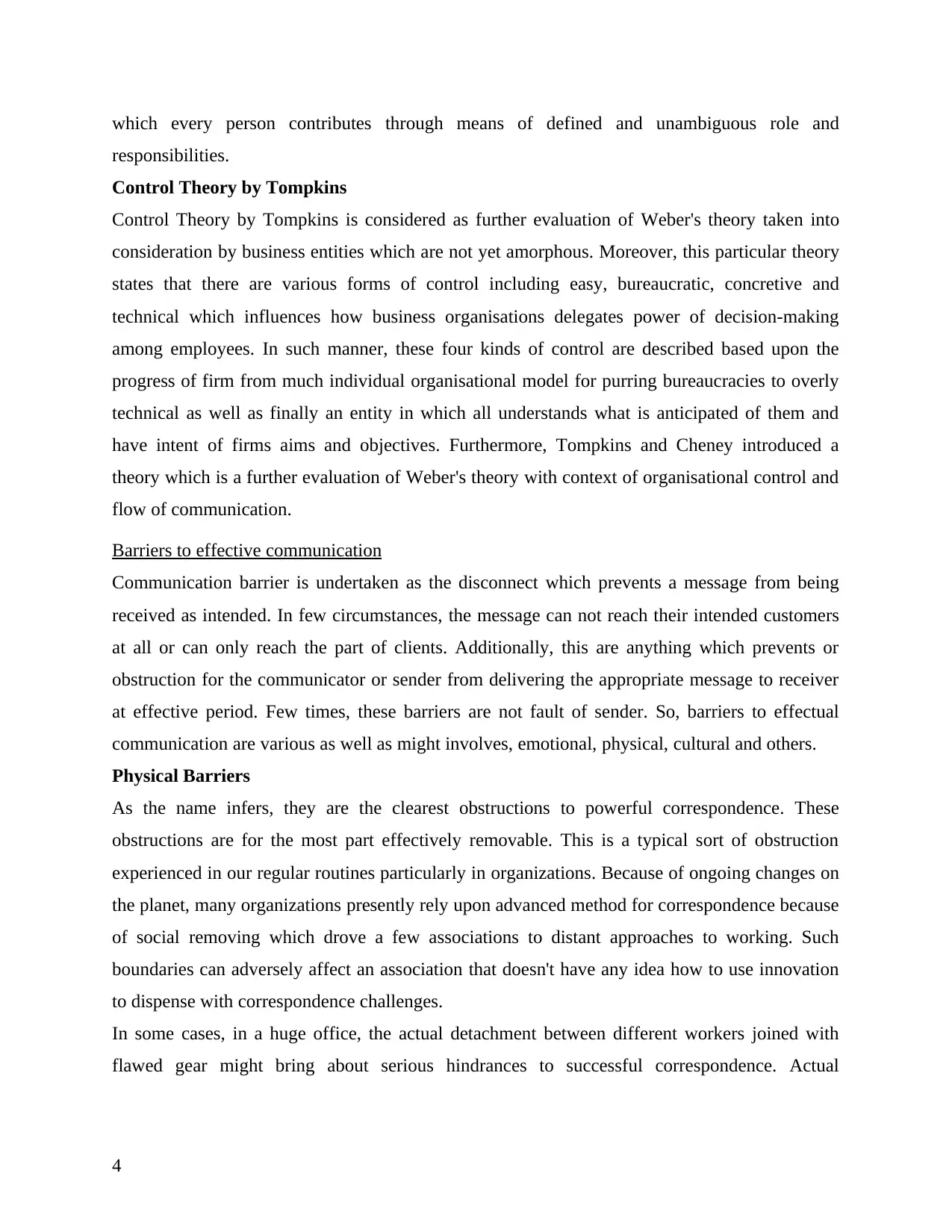
which every person contributes through means of defined and unambiguous role and
responsibilities.
Control Theory by Tompkins
Control Theory by Tompkins is considered as further evaluation of Weber's theory taken into
consideration by business entities which are not yet amorphous. Moreover, this particular theory
states that there are various forms of control including easy, bureaucratic, concretive and
technical which influences how business organisations delegates power of decision-making
among employees. In such manner, these four kinds of control are described based upon the
progress of firm from much individual organisational model for purring bureaucracies to overly
technical as well as finally an entity in which all understands what is anticipated of them and
have intent of firms aims and objectives. Furthermore, Tompkins and Cheney introduced a
theory which is a further evaluation of Weber's theory with context of organisational control and
flow of communication.
Barriers to effective communication
Communication barrier is undertaken as the disconnect which prevents a message from being
received as intended. In few circumstances, the message can not reach their intended customers
at all or can only reach the part of clients. Additionally, this are anything which prevents or
obstruction for the communicator or sender from delivering the appropriate message to receiver
at effective period. Few times, these barriers are not fault of sender. So, barriers to effectual
communication are various as well as might involves, emotional, physical, cultural and others.
Physical Barriers
As the name infers, they are the clearest obstructions to powerful correspondence. These
obstructions are for the most part effectively removable. This is a typical sort of obstruction
experienced in our regular routines particularly in organizations. Because of ongoing changes on
the planet, many organizations presently rely upon advanced method for correspondence because
of social removing which drove a few associations to distant approaches to working. Such
boundaries can adversely affect an association that doesn't have any idea how to use innovation
to dispense with correspondence challenges.
In some cases, in a huge office, the actual detachment between different workers joined with
flawed gear might bring about serious hindrances to successful correspondence. Actual
4
responsibilities.
Control Theory by Tompkins
Control Theory by Tompkins is considered as further evaluation of Weber's theory taken into
consideration by business entities which are not yet amorphous. Moreover, this particular theory
states that there are various forms of control including easy, bureaucratic, concretive and
technical which influences how business organisations delegates power of decision-making
among employees. In such manner, these four kinds of control are described based upon the
progress of firm from much individual organisational model for purring bureaucracies to overly
technical as well as finally an entity in which all understands what is anticipated of them and
have intent of firms aims and objectives. Furthermore, Tompkins and Cheney introduced a
theory which is a further evaluation of Weber's theory with context of organisational control and
flow of communication.
Barriers to effective communication
Communication barrier is undertaken as the disconnect which prevents a message from being
received as intended. In few circumstances, the message can not reach their intended customers
at all or can only reach the part of clients. Additionally, this are anything which prevents or
obstruction for the communicator or sender from delivering the appropriate message to receiver
at effective period. Few times, these barriers are not fault of sender. So, barriers to effectual
communication are various as well as might involves, emotional, physical, cultural and others.
Physical Barriers
As the name infers, they are the clearest obstructions to powerful correspondence. These
obstructions are for the most part effectively removable. This is a typical sort of obstruction
experienced in our regular routines particularly in organizations. Because of ongoing changes on
the planet, many organizations presently rely upon advanced method for correspondence because
of social removing which drove a few associations to distant approaches to working. Such
boundaries can adversely affect an association that doesn't have any idea how to use innovation
to dispense with correspondence challenges.
In some cases, in a huge office, the actual detachment between different workers joined with
flawed gear might bring about serious hindrances to successful correspondence. Actual
4
Paraphrase This Document
Need a fresh take? Get an instant paraphrase of this document with our AI Paraphraser
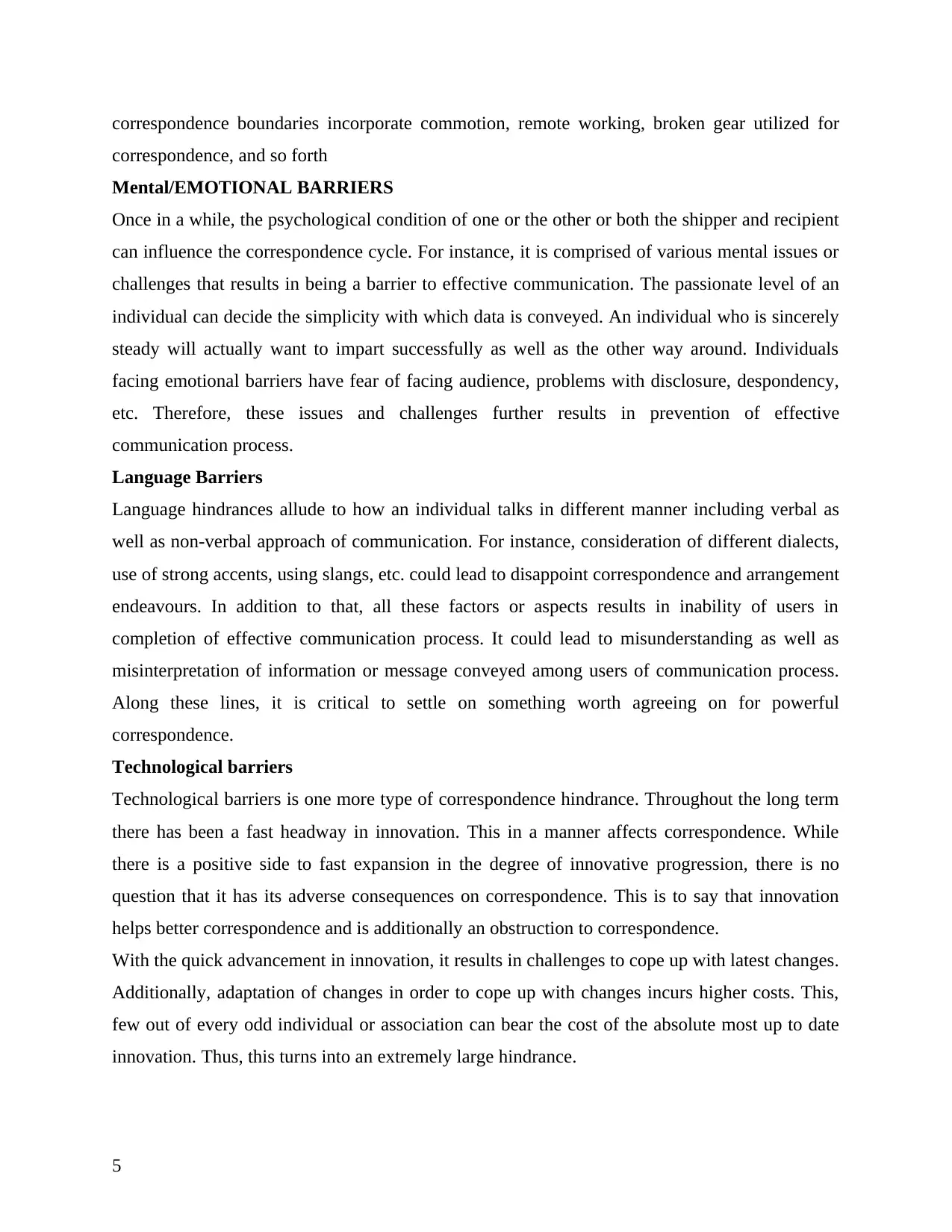
correspondence boundaries incorporate commotion, remote working, broken gear utilized for
correspondence, and so forth
Mental/EMOTIONAL BARRIERS
Once in a while, the psychological condition of one or the other or both the shipper and recipient
can influence the correspondence cycle. For instance, it is comprised of various mental issues or
challenges that results in being a barrier to effective communication. The passionate level of an
individual can decide the simplicity with which data is conveyed. An individual who is sincerely
steady will actually want to impart successfully as well as the other way around. Individuals
facing emotional barriers have fear of facing audience, problems with disclosure, despondency,
etc. Therefore, these issues and challenges further results in prevention of effective
communication process.
Language Barriers
Language hindrances allude to how an individual talks in different manner including verbal as
well as non-verbal approach of communication. For instance, consideration of different dialects,
use of strong accents, using slangs, etc. could lead to disappoint correspondence and arrangement
endeavours. In addition to that, all these factors or aspects results in inability of users in
completion of effective communication process. It could lead to misunderstanding as well as
misinterpretation of information or message conveyed among users of communication process.
Along these lines, it is critical to settle on something worth agreeing on for powerful
correspondence.
Technological barriers
Technological barriers is one more type of correspondence hindrance. Throughout the long term
there has been a fast headway in innovation. This in a manner affects correspondence. While
there is a positive side to fast expansion in the degree of innovative progression, there is no
question that it has its adverse consequences on correspondence. This is to say that innovation
helps better correspondence and is additionally an obstruction to correspondence.
With the quick advancement in innovation, it results in challenges to cope up with latest changes.
Additionally, adaptation of changes in order to cope up with changes incurs higher costs. This,
few out of every odd individual or association can bear the cost of the absolute most up to date
innovation. Thus, this turns into an extremely large hindrance.
5
correspondence, and so forth
Mental/EMOTIONAL BARRIERS
Once in a while, the psychological condition of one or the other or both the shipper and recipient
can influence the correspondence cycle. For instance, it is comprised of various mental issues or
challenges that results in being a barrier to effective communication. The passionate level of an
individual can decide the simplicity with which data is conveyed. An individual who is sincerely
steady will actually want to impart successfully as well as the other way around. Individuals
facing emotional barriers have fear of facing audience, problems with disclosure, despondency,
etc. Therefore, these issues and challenges further results in prevention of effective
communication process.
Language Barriers
Language hindrances allude to how an individual talks in different manner including verbal as
well as non-verbal approach of communication. For instance, consideration of different dialects,
use of strong accents, using slangs, etc. could lead to disappoint correspondence and arrangement
endeavours. In addition to that, all these factors or aspects results in inability of users in
completion of effective communication process. It could lead to misunderstanding as well as
misinterpretation of information or message conveyed among users of communication process.
Along these lines, it is critical to settle on something worth agreeing on for powerful
correspondence.
Technological barriers
Technological barriers is one more type of correspondence hindrance. Throughout the long term
there has been a fast headway in innovation. This in a manner affects correspondence. While
there is a positive side to fast expansion in the degree of innovative progression, there is no
question that it has its adverse consequences on correspondence. This is to say that innovation
helps better correspondence and is additionally an obstruction to correspondence.
With the quick advancement in innovation, it results in challenges to cope up with latest changes.
Additionally, adaptation of changes in order to cope up with changes incurs higher costs. This,
few out of every odd individual or association can bear the cost of the absolute most up to date
innovation. Thus, this turns into an extremely large hindrance.
5
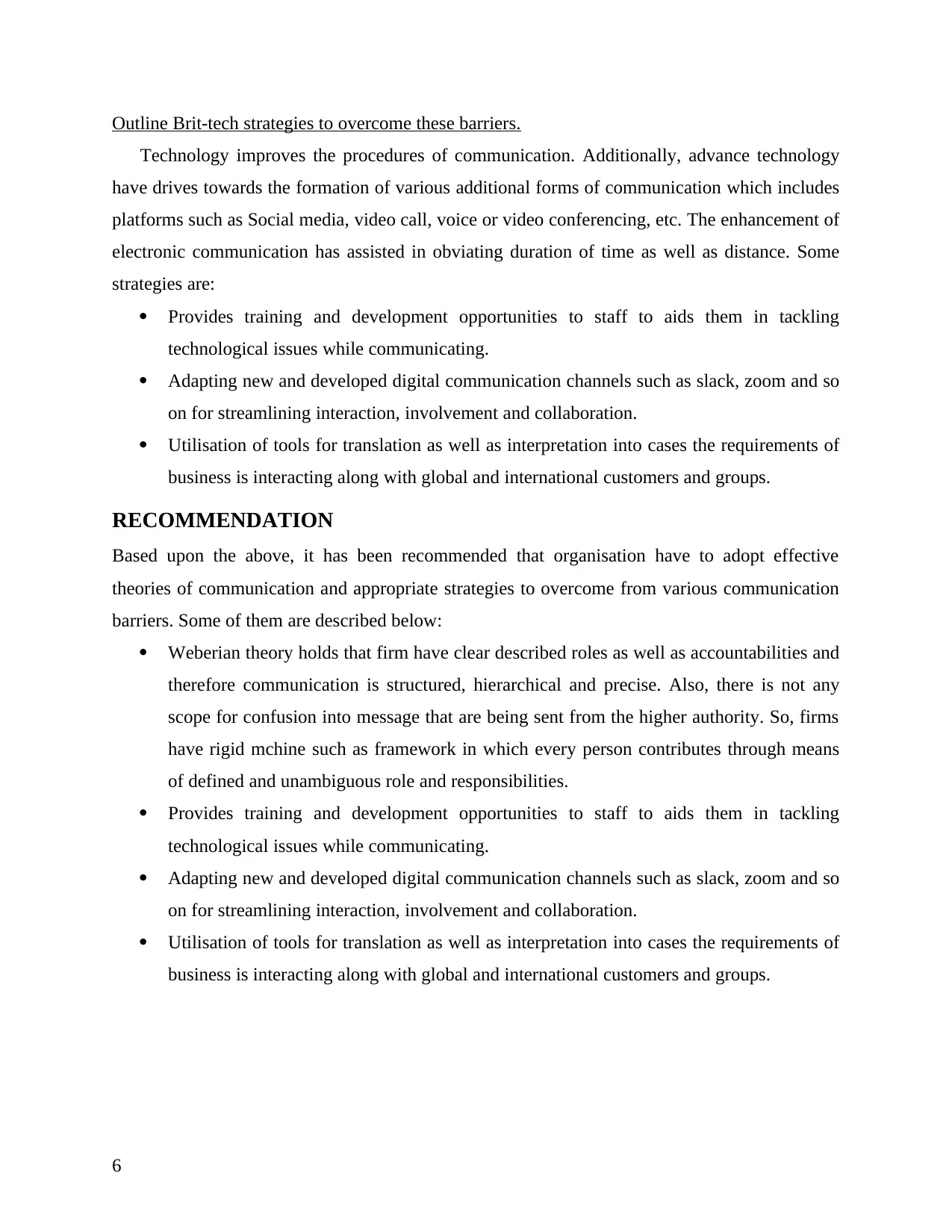
Outline Brit-tech strategies to overcome these barriers.
Technology improves the procedures of communication. Additionally, advance technology
have drives towards the formation of various additional forms of communication which includes
platforms such as Social media, video call, voice or video conferencing, etc. The enhancement of
electronic communication has assisted in obviating duration of time as well as distance. Some
strategies are:
Provides training and development opportunities to staff to aids them in tackling
technological issues while communicating.
Adapting new and developed digital communication channels such as slack, zoom and so
on for streamlining interaction, involvement and collaboration.
Utilisation of tools for translation as well as interpretation into cases the requirements of
business is interacting along with global and international customers and groups.
RECOMMENDATION
Based upon the above, it has been recommended that organisation have to adopt effective
theories of communication and appropriate strategies to overcome from various communication
barriers. Some of them are described below:
Weberian theory holds that firm have clear described roles as well as accountabilities and
therefore communication is structured, hierarchical and precise. Also, there is not any
scope for confusion into message that are being sent from the higher authority. So, firms
have rigid mchine such as framework in which every person contributes through means
of defined and unambiguous role and responsibilities.
Provides training and development opportunities to staff to aids them in tackling
technological issues while communicating.
Adapting new and developed digital communication channels such as slack, zoom and so
on for streamlining interaction, involvement and collaboration.
Utilisation of tools for translation as well as interpretation into cases the requirements of
business is interacting along with global and international customers and groups.
6
Technology improves the procedures of communication. Additionally, advance technology
have drives towards the formation of various additional forms of communication which includes
platforms such as Social media, video call, voice or video conferencing, etc. The enhancement of
electronic communication has assisted in obviating duration of time as well as distance. Some
strategies are:
Provides training and development opportunities to staff to aids them in tackling
technological issues while communicating.
Adapting new and developed digital communication channels such as slack, zoom and so
on for streamlining interaction, involvement and collaboration.
Utilisation of tools for translation as well as interpretation into cases the requirements of
business is interacting along with global and international customers and groups.
RECOMMENDATION
Based upon the above, it has been recommended that organisation have to adopt effective
theories of communication and appropriate strategies to overcome from various communication
barriers. Some of them are described below:
Weberian theory holds that firm have clear described roles as well as accountabilities and
therefore communication is structured, hierarchical and precise. Also, there is not any
scope for confusion into message that are being sent from the higher authority. So, firms
have rigid mchine such as framework in which every person contributes through means
of defined and unambiguous role and responsibilities.
Provides training and development opportunities to staff to aids them in tackling
technological issues while communicating.
Adapting new and developed digital communication channels such as slack, zoom and so
on for streamlining interaction, involvement and collaboration.
Utilisation of tools for translation as well as interpretation into cases the requirements of
business is interacting along with global and international customers and groups.
6
⊘ This is a preview!⊘
Do you want full access?
Subscribe today to unlock all pages.

Trusted by 1+ million students worldwide
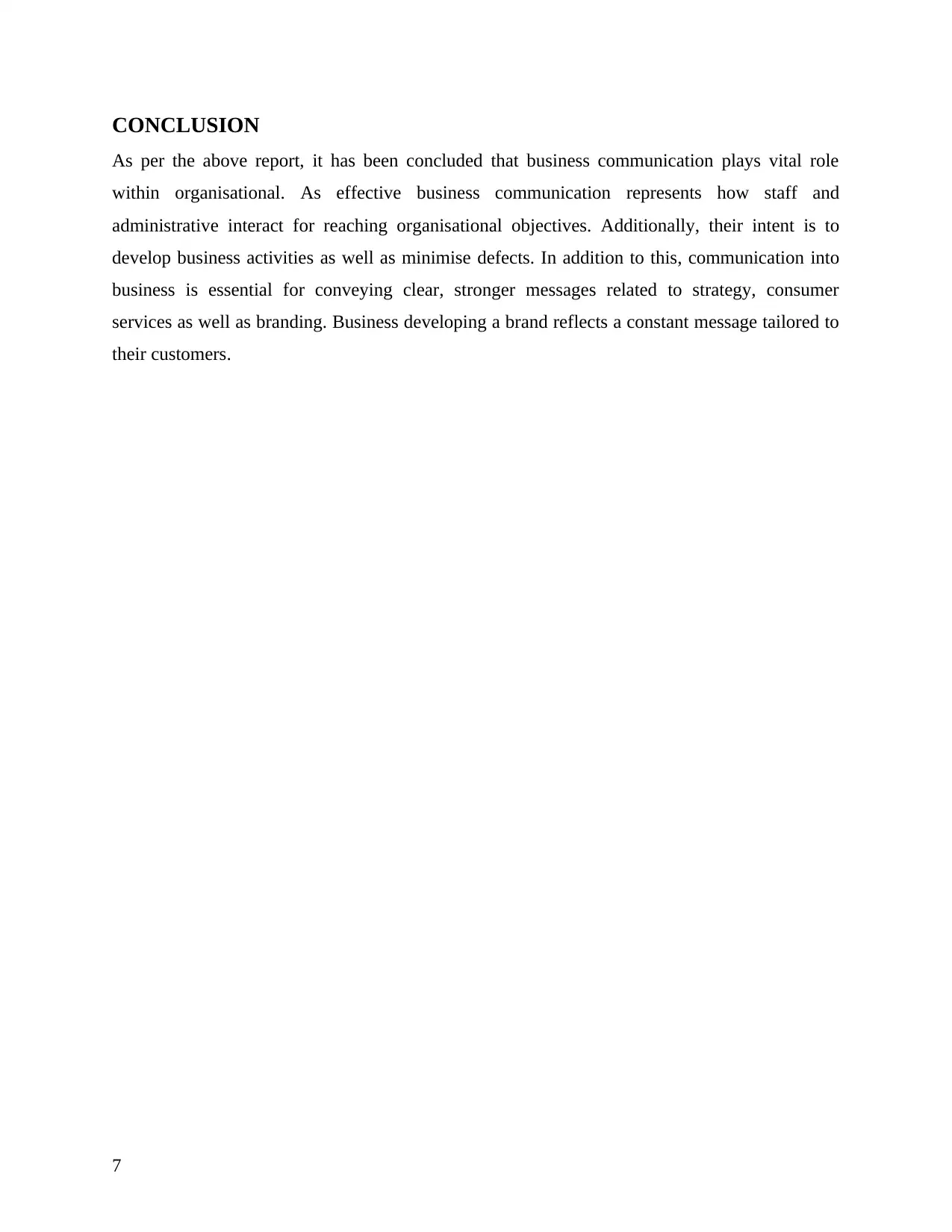
CONCLUSION
As per the above report, it has been concluded that business communication plays vital role
within organisational. As effective business communication represents how staff and
administrative interact for reaching organisational objectives. Additionally, their intent is to
develop business activities as well as minimise defects. In addition to this, communication into
business is essential for conveying clear, stronger messages related to strategy, consumer
services as well as branding. Business developing a brand reflects a constant message tailored to
their customers.
7
As per the above report, it has been concluded that business communication plays vital role
within organisational. As effective business communication represents how staff and
administrative interact for reaching organisational objectives. Additionally, their intent is to
develop business activities as well as minimise defects. In addition to this, communication into
business is essential for conveying clear, stronger messages related to strategy, consumer
services as well as branding. Business developing a brand reflects a constant message tailored to
their customers.
7
Paraphrase This Document
Need a fresh take? Get an instant paraphrase of this document with our AI Paraphraser
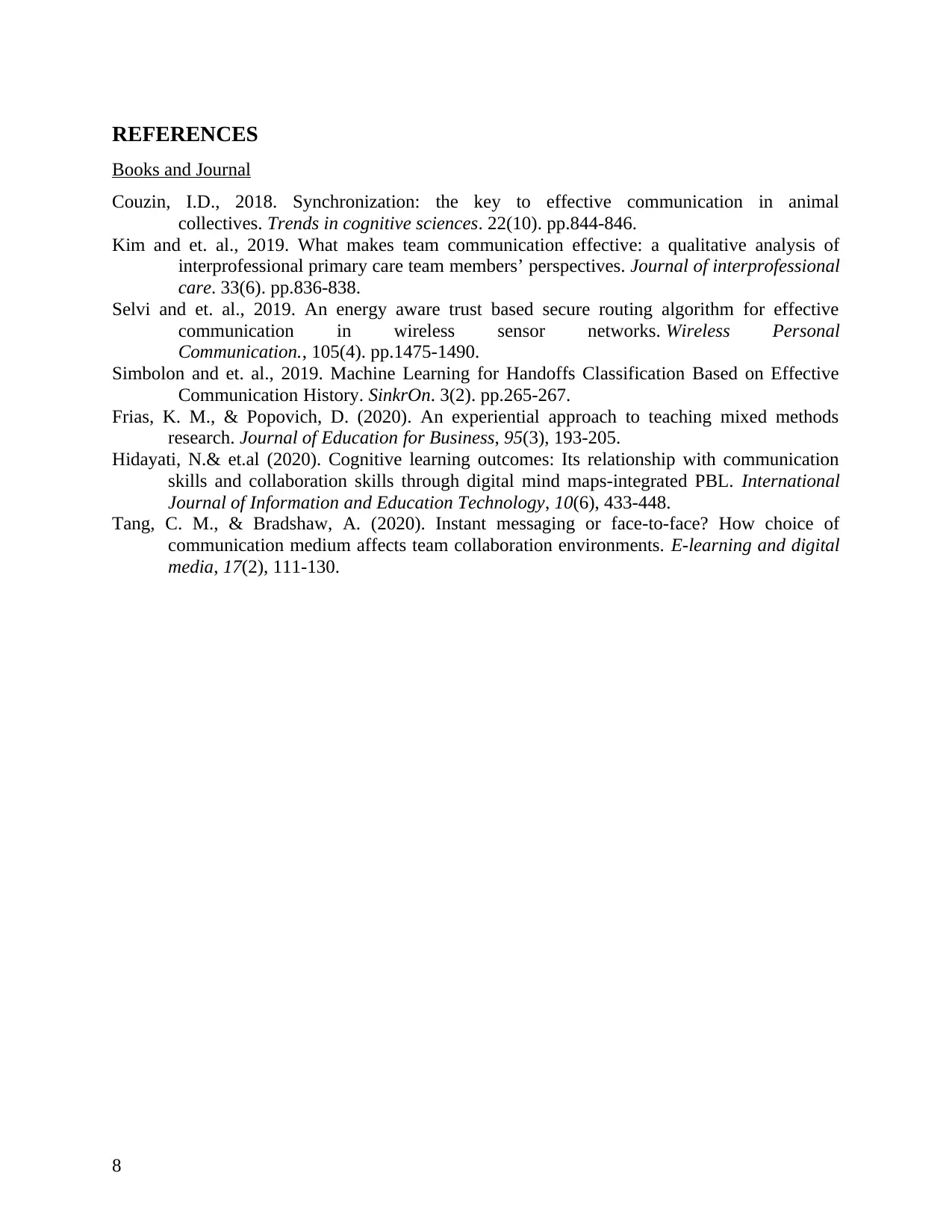
REFERENCES
Books and Journal
Couzin, I.D., 2018. Synchronization: the key to effective communication in animal
collectives. Trends in cognitive sciences. 22(10). pp.844-846.
Kim and et. al., 2019. What makes team communication effective: a qualitative analysis of
interprofessional primary care team members’ perspectives. Journal of interprofessional
care. 33(6). pp.836-838.
Selvi and et. al., 2019. An energy aware trust based secure routing algorithm for effective
communication in wireless sensor networks. Wireless Personal
Communication., 105(4). pp.1475-1490.
Simbolon and et. al., 2019. Machine Learning for Handoffs Classification Based on Effective
Communication History. SinkrOn. 3(2). pp.265-267.
Frias, K. M., & Popovich, D. (2020). An experiential approach to teaching mixed methods
research. Journal of Education for Business, 95(3), 193-205.
Hidayati, N.& et.al (2020). Cognitive learning outcomes: Its relationship with communication
skills and collaboration skills through digital mind maps-integrated PBL. International
Journal of Information and Education Technology, 10(6), 433-448.
Tang, C. M., & Bradshaw, A. (2020). Instant messaging or face-to-face? How choice of
communication medium affects team collaboration environments. E-learning and digital
media, 17(2), 111-130.
8
Books and Journal
Couzin, I.D., 2018. Synchronization: the key to effective communication in animal
collectives. Trends in cognitive sciences. 22(10). pp.844-846.
Kim and et. al., 2019. What makes team communication effective: a qualitative analysis of
interprofessional primary care team members’ perspectives. Journal of interprofessional
care. 33(6). pp.836-838.
Selvi and et. al., 2019. An energy aware trust based secure routing algorithm for effective
communication in wireless sensor networks. Wireless Personal
Communication., 105(4). pp.1475-1490.
Simbolon and et. al., 2019. Machine Learning for Handoffs Classification Based on Effective
Communication History. SinkrOn. 3(2). pp.265-267.
Frias, K. M., & Popovich, D. (2020). An experiential approach to teaching mixed methods
research. Journal of Education for Business, 95(3), 193-205.
Hidayati, N.& et.al (2020). Cognitive learning outcomes: Its relationship with communication
skills and collaboration skills through digital mind maps-integrated PBL. International
Journal of Information and Education Technology, 10(6), 433-448.
Tang, C. M., & Bradshaw, A. (2020). Instant messaging or face-to-face? How choice of
communication medium affects team collaboration environments. E-learning and digital
media, 17(2), 111-130.
8
1 out of 8
Related Documents
Your All-in-One AI-Powered Toolkit for Academic Success.
+13062052269
info@desklib.com
Available 24*7 on WhatsApp / Email
![[object Object]](/_next/static/media/star-bottom.7253800d.svg)
Unlock your academic potential
Copyright © 2020–2025 A2Z Services. All Rights Reserved. Developed and managed by ZUCOL.





